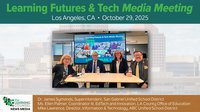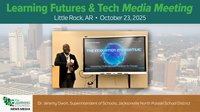School libraries have long been seen as quiet sanctuaries filled with dusty books and hushed voices–sometimes unstimulating and sleepy spaces where students go to read, study, and find information in printed sources. However, as the heart of many school buildings, libraries continue to play an important role in fostering critical thinking and personal growth, and as learning evolves, so must these important spaces.
Transforming libraries into up-to-date, dynamic, and engaging hubs is essential for fostering a love of learning and meeting the diverse needs of today’s students. By making libraries more accessible, interactive, and relevant, we can create environments that inspire curiosity, support literacy, and empower students to thrive in an increasingly digital world.
Here are five ways school districts can give their libraries a modern makeover and maximize these valuable resources:
Out with the Old
Physical materials wear out, new research emerges, and lesson plans are updated. Weeding out irrelevant and seldom-used items creates space for new resources and ensures all available information is both accurate and up-to-date.
While necessary, the weeding process can be overwhelming—especially for libraries with larger collections—so districts should begin by creating a weeding and collection development action plan. Establish what criteria will be used to remove books, such as outdated information, poor circulation rates, or poor physical condition. Also make sure to think through a system for donating, recycling, or repurposing materials (would that old book make a fun display or art project?). It’s important to involve the school community in this process—ask teachers to review subject-specific books and engage students in conversations about what books they enjoy to help guide decision-making.
Time is of the essence when a library is under “construction”, so districts may want to engage with a partner to expedite the process. The right resource can help with everything from making data-driven decisions using circulation statistics to lending helping hands to reshelve and reorganize physical materials, and even completely rebuild a space from the ground up, if needed.
Tap into Tech
Integrating technology into school libraries is not just a forward-thinking upgrade—it is a necessity for preparing students for the future. In a world where digital skills are essential for nearly every profession, school libraries must evolve beyond shelves of books to become hubs of 21st-century learning.
By providing students with access to digital tools like coding kits, smartboards, 3D printers, multimedia production equipment, tablets, games, and other digital platforms, libraries can foster the critical thinking, research, and tech-savviness that students need to thrive.
Additionally, tech-rich libraries level the playing field, offering equitable access to digital resources for all students, regardless of their socioeconomic background. Libraries should be spaces where all students are free to explore not only books but also the digital tools and skills that will shape their futures.
Strategic Spaces
By transforming traditional layouts with movable furniture, cozy reading nooks, and tech-enabled collaborative areas, libraries can better support group projects, individual study, and creative exploration.
Bringing in mixed-use furniture, movable partitions, and diverse seating arrangements can create spaces that can be easily reconfigured to accommodate various group sizes and activities. Design elements such as writable surfaces, multimedia stations, and intentionally placed power outlets can be integrated to support group work, discussions, collaborative projects, and technology use.
Digital Leap
Expanding the library's digital tools is one of the most impactful steps a school can take to prepare students for a future shaped by technology. By incorporating features like online databases, e-books, streaming media services, digital learning platforms, and coding tools, students can sharpen their digital literacy skills and learn in new ways. Many digital tools can also easily integrate with existing school learning management systems to provide seamless access to library resources within the classroom environment.
Also, by investing in robust digital collections, libraries can provide students with round-the-clock access to a wealth of information, regardless of location or schedule, and transform passive learning into immersive hands-on experiences.
Empowering Educators
It’s crucial to equip all library staff with the necessary training and skills to ensure the space remains functional and well-managed long term. Not only do they need to be able to oversee daily management to maintain organization, they also need to have a masterful understanding of all digital tools and software to troubleshoot and provide important system updates when necessary. Also, knowledgeable staff are better equipped to support teachers in integrating digital resources into their curriculum, fostering a seamless learning experience that benefits everyone.
When we invest in reimagining our school libraries, we invest in the future of education, fostering a generation of critical thinkers and creative problem-solvers ready to tackle the challenges ahead. Revitalizing these spaces transforms them from simply places to find books into dynamic environments where ideas come to life and imagination knows no bounds.
About the authors
Lee Alatorre is the Managed Services Destiny-Certified Consultant for Follett Software
Linda Crear is the Managed Services Project Manager for Follett Software.
Antje Miller is the Managed Services Project Lead for Follett Software.
Mary Puleo is the K-12 District Library Coordinator for Everett Public Schools in Everett, Massachusetts.











